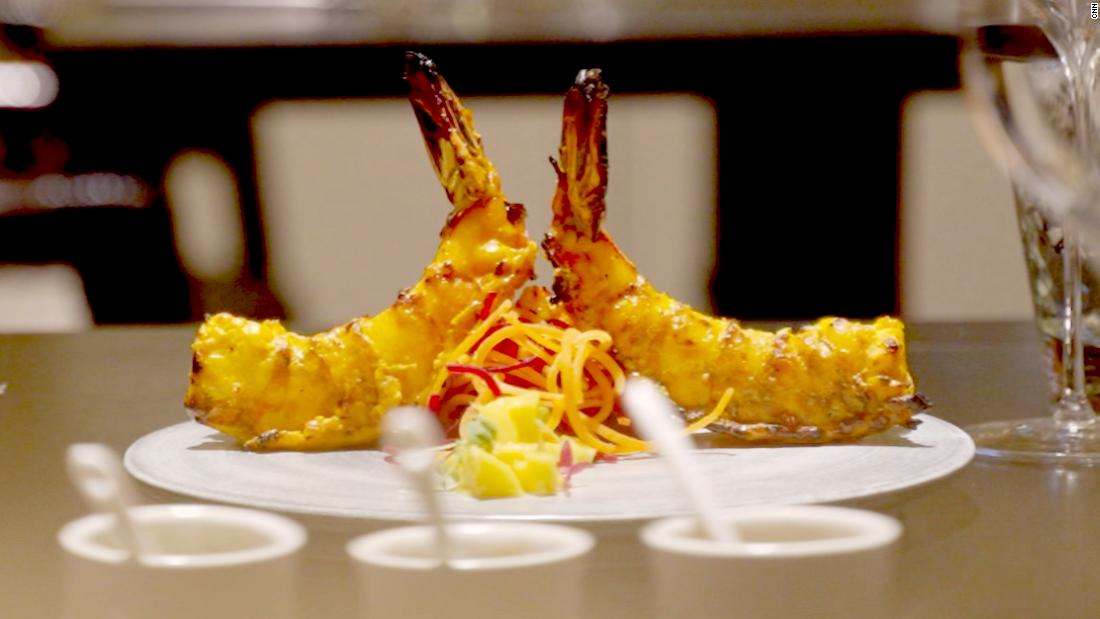
(CNN) — The term "Indian cuisine" covers a lot of ground. From the Himalayan peaks in the northern state of Uttarakhand, to the tropical southwestern coast of Kerala, each landscape comes with its own climate, history, trade links and religious customs. And each has a unique food culture.
While curry houses with standard menus are still popular, the world's taste for Indian fine dining is evolving to encompass lesser known regional delicacies and bolder experimentation.
Indian chefs living around the world are feeding this growing movement, with menus that celebrate their family heritage, while bringing new dimensions to traditional cooking techniques and recipes.
CNN spoke to five of these culinary ambassadors about the dishes that -- for them -- capture the delicious diversity of India.
Chef Jessi Singh: Buffalo milk kebab, Punjab
Chef Jessi Singh was born in Punjab, India, and grew up between Australia and America. He brings his unique culinary journey to modern Indian cuisine, including his signature buffalo milk kebabs.
When it comes to making a kebab, milk curd probably isn't the first ingredient that springs to mind. But for Punjab-born chef and restaurateur, Jessi Singh, this is the ultimate taste of home.
Crispy on the outside, with a soft, creamy center, kebabs made with curd, yogurt or paneer cheese are a popular appetizer in restaurants across northern India.
Born in a farming village outside of Punjab's capital, Chandigarh, Singh encountered the dish -- and its key ingredients -- at source.
"Before I even turned 10, I knew how to milk the buffaloes," he says.
Singh takes charge of fermenting the milk for the kebabs in his restaurants in Australia, including Melbourne's Daughter in Law and Don't Tell Aunty in Sydney. Served with an orchid and bright pink beetroot sauce, his kebabs might not look like the meals he ate as a child, but the vivid colors represent Singh's Punjab heritage in other ways.
"Back home, color doesn't associate with a gender, or a certain people, or a class," he says. "Color belongs to everyone. You will see men wearing pink turbans, a red shirt ... We are a very, very colorful culture. So that's what I put in my food."
Chef Garima Arora: Millet roti, Telangana
Garima Arora is the first and only female Indian chef to earn a Michelin star for her restaurant in Bangkok, Thailand. Now she's putting the spotlight back on India, starting with Telangana -- the southern Indian state she was born in.
Not content with her own trailblazing accolades, Arora is taking another approach to "rewrite this narrative around Indian cooking."
"There was a big difference between the way urban Telangana eats to the rural Telangana to the tribal Telangana," Arora says. "The idea was to take that and show it to the world."
Arora is giving millet a fine-dining update as a roti tartlet, filled with creamy, chilled crab and fresh coconut. She says her "cold curry" gives the "sensation of eating something fresh, cool, earthy -- but in one bite."
Chef Deepanker Khosla: Mutton biryani, Uttar Pradesh
Biryani is one of the most popular Indian dishes of all time. Chef Deepanker Khosla is adding a new chapter to biryani's layered history in his zero-waste restaurant in Thailand.
"My dad has this beautiful kitchen garden," Khosla says, "So harvesting our own produce, eating fresh, sustainable ... this is tradition."
A hydroponic system on the restaurant terrace recycles rainwater to grow plants and tilapia fish, while all waste from the kitchen is recycled back into fish food and compost.
The restaurant farm supplies almost all the produce for Khosla's "neo-Indian" menu, a modern, high-end take on centuries-old Indian dishes.
It made its way into the cuisine of almost every region, each suffusing the dish with its own flavors and techniques.
Khosla makes a version known as Awadhi biryani -- a beloved dish back home in Uttar Pradesh.
Lightly spiced pieces of mutton and rice are layered into a pot, sealed with dough, and slowly steamed for hours, in "dum pukht" style.
"Dum pukht means slow breathing, so you let the food breathe in its own juices," Khosla says.
With an ever-evolving menu that adapts to the seasonal produce that can be grown on the farm, Khosla is excited to spotlight authentic, regional recipes.
What we know about Indian cuisine is "not even the tip of the iceberg," he says. "India has 22 distinct cuisines with more than 5,000 different dishes ... that is what I take pride in."
Chef Palash Mitra: Fish curry, West Bengal
Chef Palash Mitra has mastered a range of South Asian delicacies in his Hong Kong restaurants. But for the West Bengal-born chef, one dish is closer to the heart: Bengali fish curry.
Fish is a staple in West Bengal's cuisine largely because of geography. Crisscrossed by rivers that flow into the Bay of Bengal, the east Indian state boasts a huge variety of fish. And the importance of fish carries into ritual life too.
"Whether it's a funeral or if it's a marriage, fish is an integral part of it," says Palash Mitra, a chef born in West Bengal's capital, Kolkata. "Fish is the symbol of a new life, the end of life. It's entwined."
As culinary director of South Asian cuisine for Hong Kong's Black Sheep restaurant group, Palash supervises four restaurants, which offer fish dishes that span the Indian subcontinent.
"The tandoori cobia ... or the salmon ... these are really, really popular dishes," he says.
But Bengali fish curry is the dish that's "very close to my heart," he says. Mitra cooks his mother's recipe: chunks of rui, a South Asian carp, slowly simmered in a light broth, enriched with spices, potatoes, cauliflower and tomatoes, and served with rice. He plans to put it on the menu at his restaurant, Rajasthan Rifles on Hong Kong's Victoria Peak, this summer.
Chef Kuldeep Negi: Tandoori prawns, Delhi
Spices are at the heart of all Indian food and Chef Kuldeep Negi understands them better than most. In his Singapore restaurant, Negi serves up a bite of his Delhi heritage -- with a kick.
As a child, Negi's mother brought him to the market, and taught him how to select and blend the spices.
"She is very particular about choosing the spices because India is a country of different seasons. So each season has different spices," says Negi. "How to use them, when to add into the dish, how long you're going to cook (them) -- that's very important."
The art of blending spices is still an important part of Negi's cooking today. Though you're more likely to find chicken or lamb grilling in the tandoors of landlocked Delhi, Negi wants to make the most of the seafood available in Southeast Asia.
For his signature dish, tandoori prawns, he brings out the succulent, smoky flavors of the jumbo prawns with his unique spice mix: saffron, turmeric and red chili powder, blended with rose petal, bleached cardamom and green cardamom.
"When you go to bite that, you will feel it, the freshness of the powders," he says. "It's all about the spices."
"dish" - Google News
January 19, 2021 at 09:08AM
https://ift.tt/3sDbjRq
Five dishes that define India's diverse cuisine -- and the chefs taking them global - CNN
"dish" - Google News
https://ift.tt/2MXZLF4

No comments:
Post a Comment